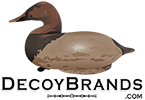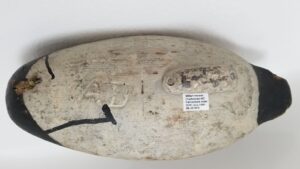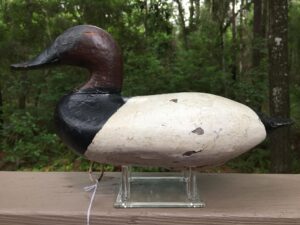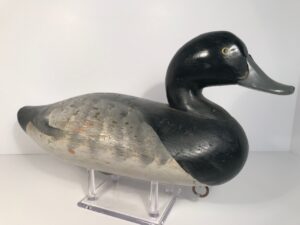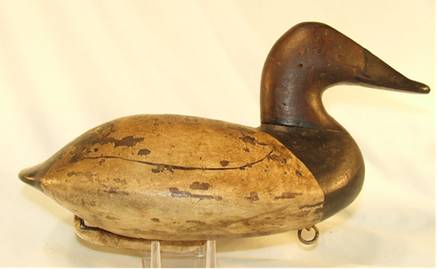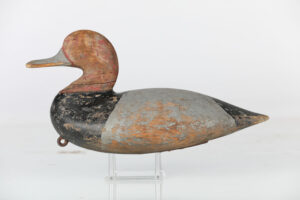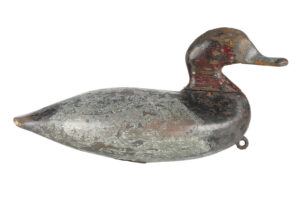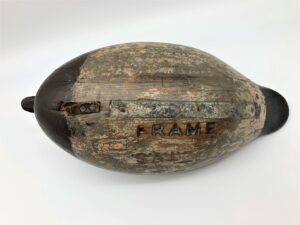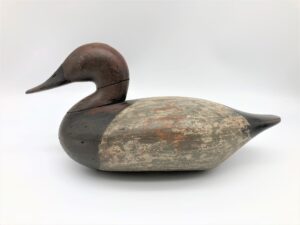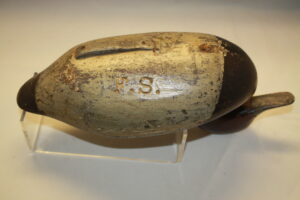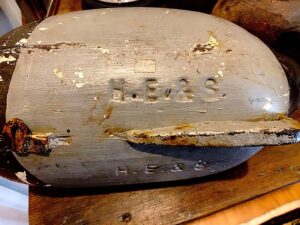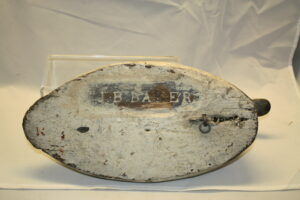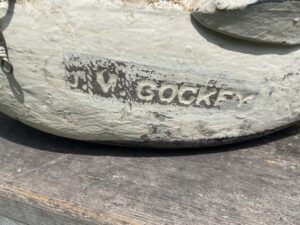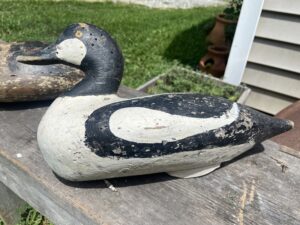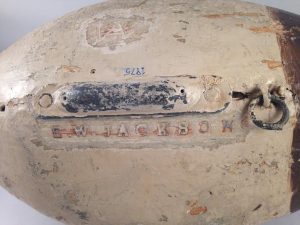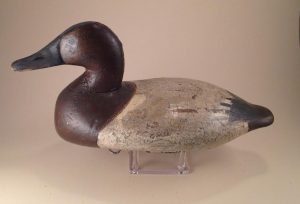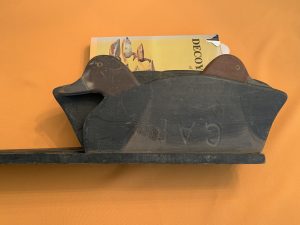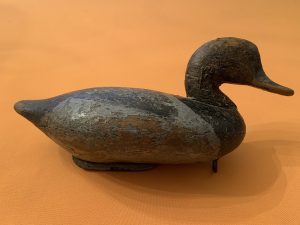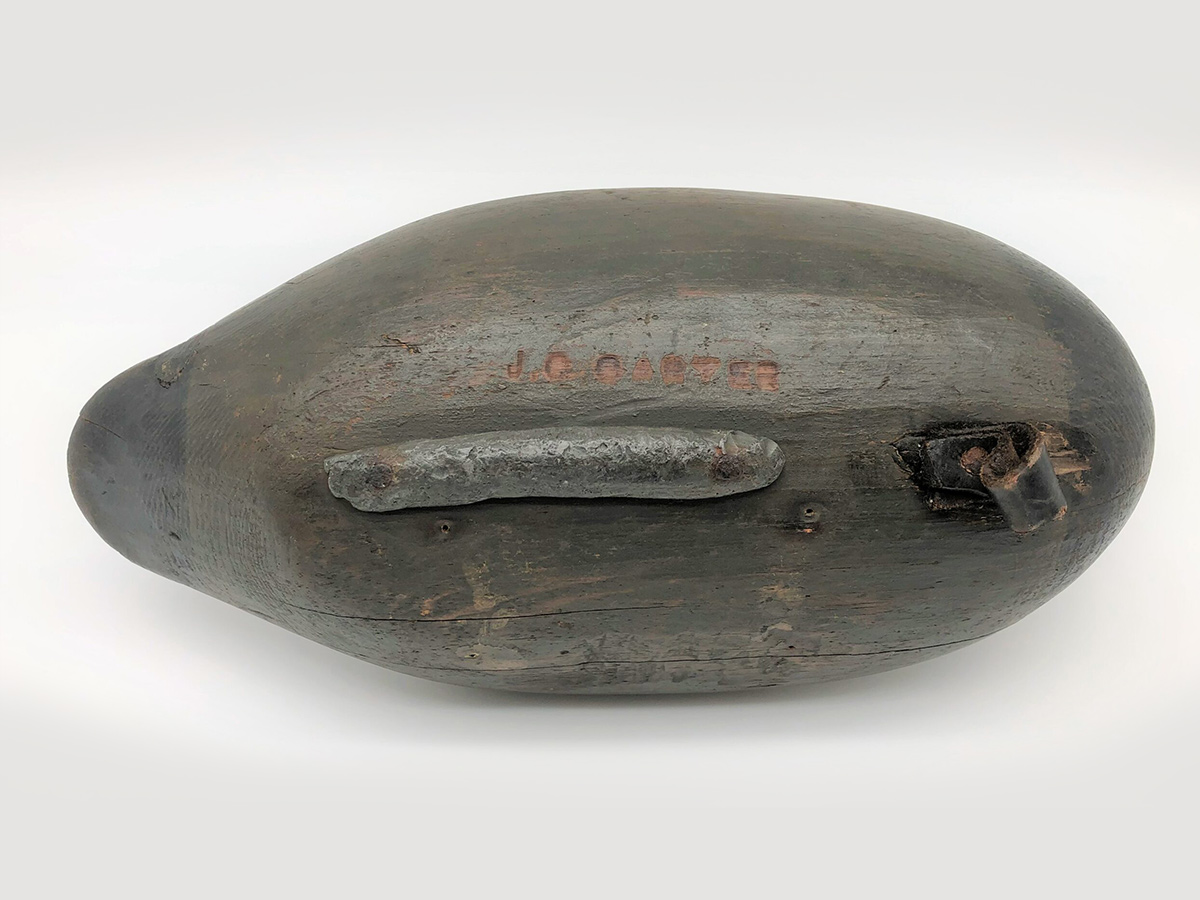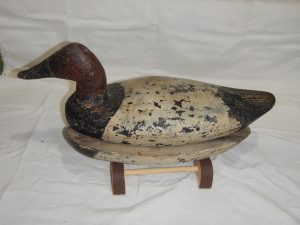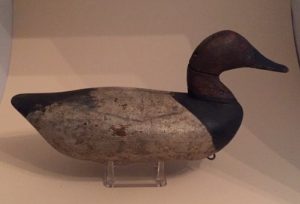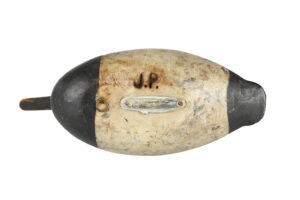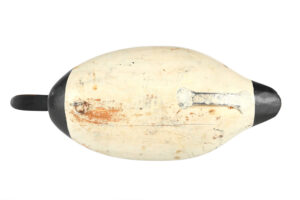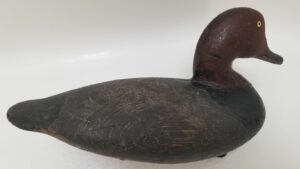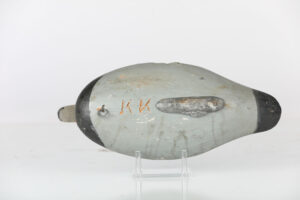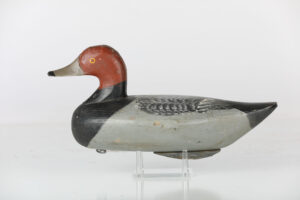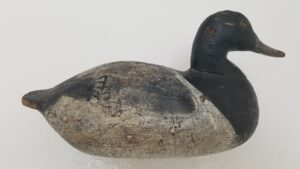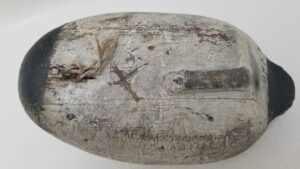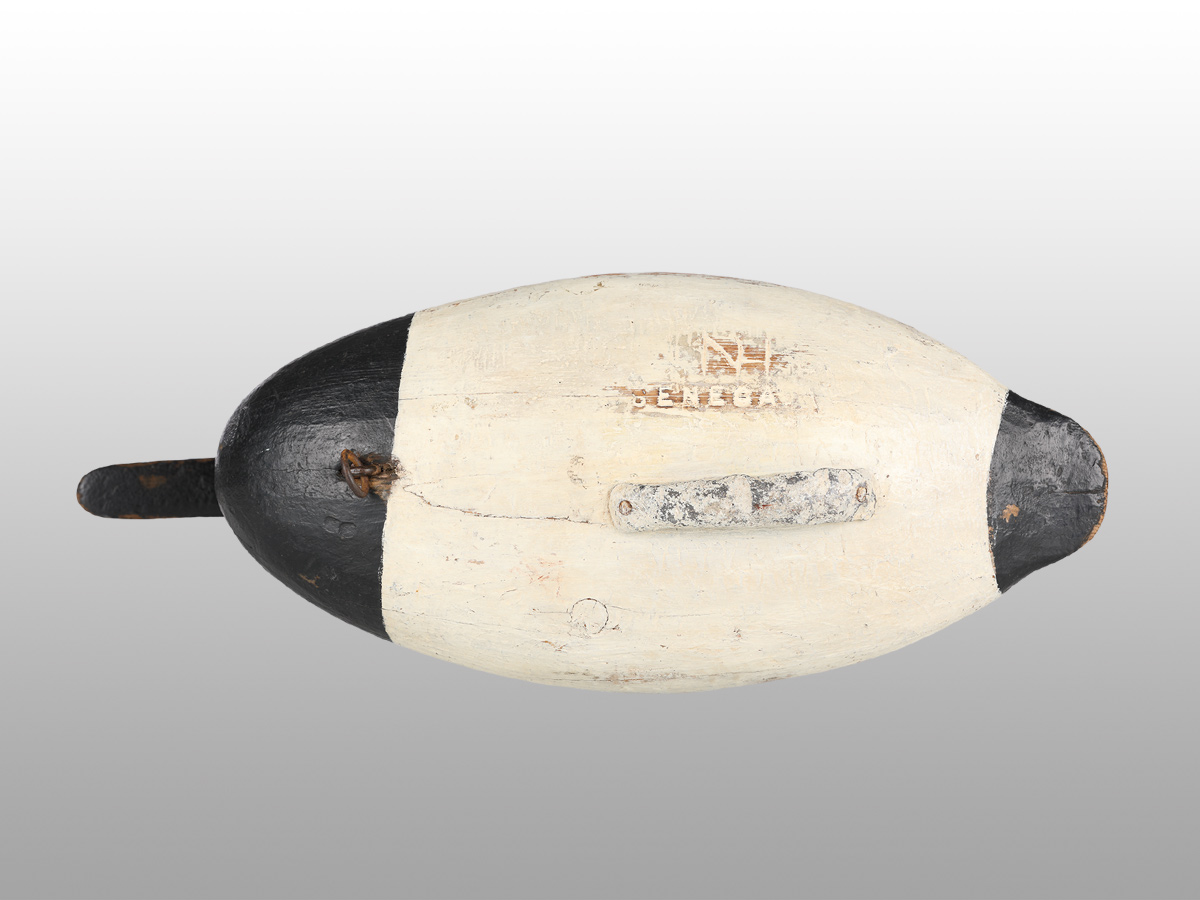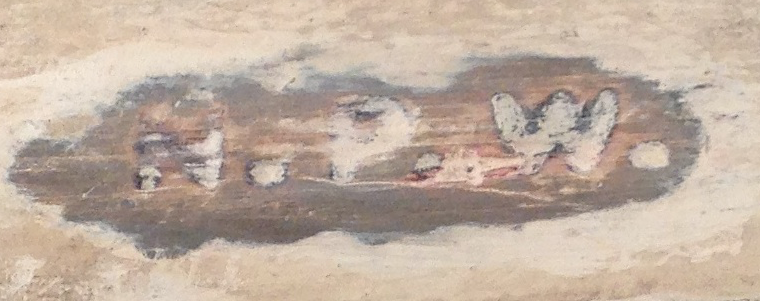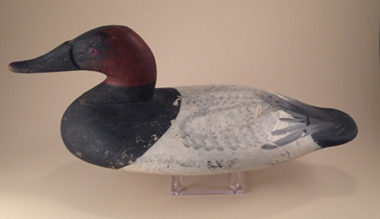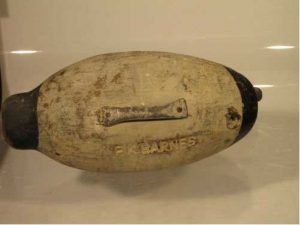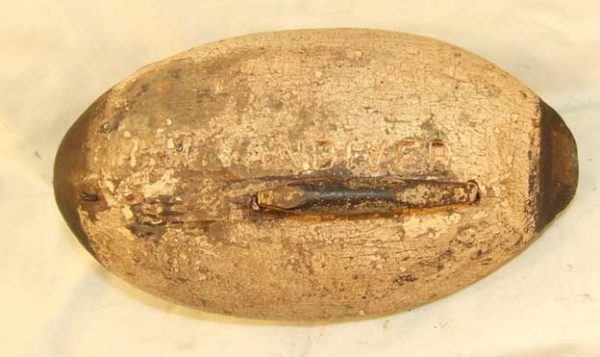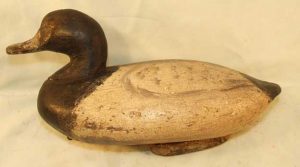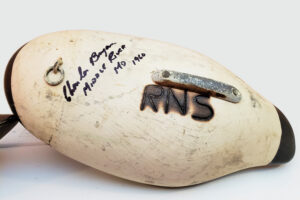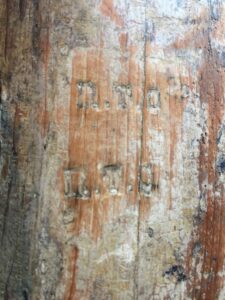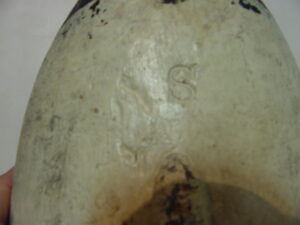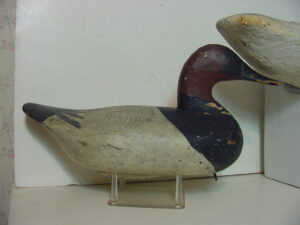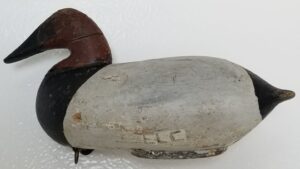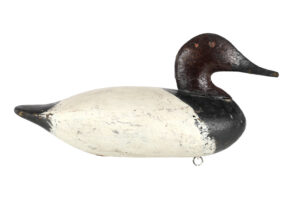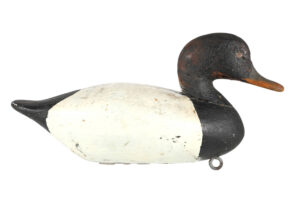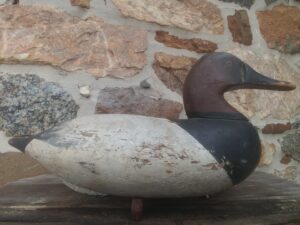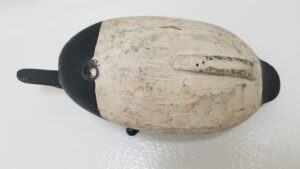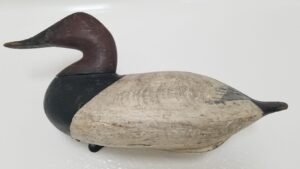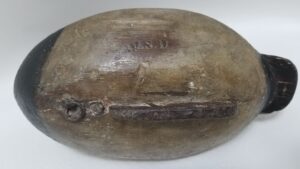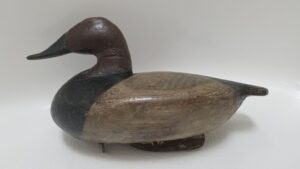UPPER CHESAPEAKE BAY INDIVIDUAL BRANDS
Upper Chesapeake Bay Individual Brands will be listed here.. A-Z order
AD
Click on any image to enlarge
PHYSICAL DESCRIPTION OF BRAND:
AD is a burned brand identifying an individual hunter. Letters are capitalized with the right post of A extended into D, top and bottom of D are extended, but no serifs; brand is 2″ wide by 1″ high.
BACKGROUND:
AD is the brand attributed to Albert Denbow (1892-1971) of Benson, MD. Benson is an unincorporated community in Harford County, MD that is generally referred to as the Fallston area. Denbow who was said to have operated a sinkbox on the Susquehanna Flats in the 1920s-1930s. The brand is on a canvasback drake made by William Heverin, Charlestown MD circa 1890. This brand has also been found on the famous Cleveland canvasbacks.
THIS BRAND HAS BEEN IDENTIFIED ON THE FOLLOWING DECOYS:
| MAKER | SPECIES | SEX | OTHER BRANDS ON DECOY |
|---|---|---|---|
| William Heverin | Canvasback | Drake | |
| Unknown | “Cleveland” Canvasback | Drake | |
| Unknown | “Cleveland” Canvasback | Hen | |
REFERENCES/SOURCES:
INITIAL CONTRIBUTOR:
Steven Brown
ADDITIONAL CONTRIBUTORS:
Kevin Peel
CCC (One C stacked over two Cs)
Click on any image to enlarge
PHYSICAL DESCRIPTION OF BRAND:
CCC is a burned brand with letters forming a triangle, one C stacked over two C’s. Each letter is 1/4″ high, and the branding iron may have been just a single letter applied three times.
BACKGROUND:
The brand owner, be it an individual, club or company, is not presently known. It appears on a canvasback drake by Joseph Dye (1869-1931) of Havre de Grace MD.
THIS BRAND HAS BEEN IDENTIFIED ON THE FOLLOWING DECOYS:
| MAKER | SPECIES | SEX | OTHER BRANDS ON DECOY |
|---|---|---|---|
| Joseph Dye | Canvasback | Drake | |
REFERENCES/SOURCES:
INITIAL CONTRIBUTOR:
Patricia Bowers
ADDITIONAL CONTRIBUTORS:
CH
Click on any image to enlarge
PHYSICAL DESCRIPTION OF BRAND:
Carved CH in block letters, no periods. Brand is 7/16″ high x 1 7/8″ wide.
BACKGROUND:
Carved rig owner initials CH on bottom, possibly for Charles P. Holden of North East, who operated a sinkbox, or one of three other known duck hunters from that era on the Susquehanna Flats. The hope is that one or more similarly branded decoys of known rig ownership will eventually come to light.
THIS BRAND HAS BEEN IDENTIFIED ON THE FOLLOWING DECOYS:
| MAKER | SPECIES | SEX | OTHER BRANDS ON DECOY |
|---|---|---|---|
| George Washington Barnes | Redhead | Drake | Initials stamped on weight, difficult to read, possibly MWS or SMW |
REFERENCES/SOURCES:
Duck Hunters on the Susquehanna Flats 1850-1930, Peden, H.C. and Shagena, J. L., copyright 2014
INITIAL CONTRIBUTOR:
Steven Brown
ADDITIONAL CONTRIBUTORS:
CWJ
Click on any image to enlarge
PHYSICAL DESCRIPTION OF BRAND:
CWJ is a burned brand in block capital letters measuring 1 5/8″ wide x 3/8″ high.
BACKGROUND:
The CWJ brand is Charlie William (Speed) Joiner’s personal brand he used on decoys in his personal hunting rig. Joiner gunned from the 1940s up until the 1960s. This brand can be found on decoys he carved himself as well as decoys he found along the shore and added to his personal rig. Joiner’s infamous duck head signature may or may not be on a branded decoy as most decoys branded CWJ were made in the 1950s and 1960s before he started signing decoys.
THIS BRAND HAS BEEN IDENTIFIED ON THE FOLLOWING DECOYS:
| MAKER | SPECIES | SEX | OTHER BRANDS ON DECOY |
|---|---|---|---|
| Charlie Joiner | Bluebill | Drake | None |
| Charlie Joiner | Redhead | Drake | None |
REFERENCES/SOURCES:
INITIAL CONTRIBUTOR:
Gregory Partin
ADDITIONAL CONTRIBUTORS:
DYE
Click on any image to enlarge
PHYSICAL DESCRIPTION OF BRAND:
DYE (serifs, all caps, no dots after letters) is a burned brand identifying a gunner/owner. Letters are 11/16” high, and each is ¾” wide, including serifs. Entire brand is 2 ½” wide x 11/16” high. There is a freeform “h” superimposed over the “Y,” although the intent of the alteration isn’t known. The superimposed “h” was actually part of the brand applied to this decoy.
BACKGROUND:
This brand is on a canvasback drake made by John B. Graham, Charlestown MD, circa 1887. At one point it was part of a rig used by market hunter Richard K Barnes of Carpenters Point, Cecil County MD and bears his mark as well. The identical brand, complete with superimposed “h,” was used on at least two other known decoys of similar vintage, and others may exist. Given that few collectors have seen the brand, one assumes it was never used by the Dye family on any of their rigs, but little is known for certain.
THIS BRAND HAS BEEN IDENTIFIED ON THE FOLLOWING DECOYS:
| MAKER | SPECIES | SEX | OTHER BRANDS ON DECOY |
|---|---|---|---|
| John B. Graham | Canvasback | Drake | RKB for Richard K. Barnes, 1865-1934 |
| John B. Graham | Black Duck | Drake | |
| Ben Dye | Canvasback | Drake | GRACE |
| John B. Graham | Canvasback | Drake | |
REFERENCES/SOURCES:
INITIAL CONTRIBUTOR:
Steven Brown
ADDITIONAL CONTRIBUTORS:
Jim Lockard, Rod Schwarm, John Cox
E.L.B
Click on any image to enlarge
PHYSICAL DESCRIPTION OF BRAND:
The E.L.B is an embossed brand on a cast iron weight identifying an individual hunter. The letters are block and capitalized with periods after the E and the B. The brand is 1/2″ in height x 1 7/8 ” in width.
BACKGROUND:
E.L.B is the brand of Edward L. Bartlett (1846-1905) of Baltimore, MD. Bartlett was a partner in the Bartlett and Hayward Company, a metalworking foundry located in Baltimore and was one of the most respected businessmen of his time. Bartlett and his partner, Thomas J. Hayward, owned extensive gunning shores on the Gunpowder Neck along the Bush River. They also owned the steamship Comfort that they used to entertain guests as well as gun from a sink box rig on the Susquehanna Flats. The cast iron weights bearing their initials were cast in their foundry. Two styles of these weights have been identified, one having a single screw and the other a double screw. There are also two different styles of letters, one block and one serif. Mr. Bartlett’s rig of was primarily made up of decoys made by Ben Dye of Stumps Point, Cecil County, MD. At least one example has surfaced on a John “Daddy” Holly redhead.
THIS BRAND HAS BEEN IDENTIFIED ON THE FOLLOWING DECOYS:
| MAKER | SPECIES | SEX | OTHER BRANDS ON DECOY |
|---|---|---|---|
| Ben Dye | Redhead (Style 1) | Drake | |
| Ben Dye | Redhead (Style 2) | Drake | |
| John “Daddy” Holly | Redhead repainted as a blue bill | Drake | |
REFERENCES/SOURCES:
“Waterfowling on the Chesapeake, 1819-1936” by C. John Sullivan
“Baltimore, Its History and Its People” Lewis Historical Publishing Company
INITIAL CONTRIBUTOR:
Kevin Peel
ADDITIONAL CONTRIBUTORS:
FRAME
Click on any image to enlarge
PHYSICAL DESCRIPTION OF BRAND:
FRAME is a burned brand in the bottom of a circa 1880s John “Daddy” Holly canvasback drake. Block letters, all CAPS. The brand measures 3 1/6″ wide x 1/2″ high.
BACKGROUND:
The Narrows Island Club was one of the most prestigious gunning clubs in North Carolina during waterfowling’s “golden age.” It was located in Currituck County, in the vast marshes south of Poplar Branch Landing, stretching from the western shores of the Narrows of Currituck Sound, all the way south to the marshes near Dowdy’s Bay at Grandy, including Neal’s Creek.
Following its original organization in 1881 as the Kitty Hawk Bay Sportsman’s Club, and then the Kitty Hawk Club, the Narrows Island Club was formally established in 1882, with 24 charter members, most of them from New York. Many of these wealthy “sports” had gunned on the Susquehanna Flats, and so were quite familiar with the exceptional decoys made there by John “Daddy” Holly. Knowing they would work perfectly in the club’s new settings, an order was placed for canvasbacks and redheads sometime around 1882 or 1883.
The bird is branded “FRAME” for Charles Pleasant Frame (1839-1903) of Manhattan, New York. Frame joined the club as one of the 24 charter members on July, 21 1883, and served as the club’s vice president from 1884-1885, the same year D.G. Elliott was first elected to serve as its president.
The bird is branded “C.T.V.S.” for Charles Townsend Van Santvoord (1854-1895) of Albany, New York, joined the club on January 28, 1892. Given their respective dates of election to the club, this suggests that the bird was initially procured by or for Charles Frame, and then passed to Van Santvoord.
The “CLUB” brand was most likely applied by Narrows Island Club guides after Van Santvoord’s passing, when the bird probably become the property of the club, for the communal use of its members. Another possibility is that the brand was applied by Caroline Van Slyck, who owned and operated an inn for visiting sports at nearby Poplar Branch, and that this was part of the rig of “club” decoys loaned to guests. A third, but less likely possibility, is that the “CLUB” brand was applied by guides when the Narrows Island Club was absorbed into the Currituck Shooting Club in 1940.
THIS BRAND HAS BEEN IDENTIFIED ON THE FOLLOWING DECOYS:
| MAKER | SPECIES | SEX | OTHER BRANDS ON DECOY |
|---|---|---|---|
| John “Daddy” Holly | Canvasback | Drake | C.T.V.S. (2 1/2″ wide x 1/2″ high) and CLUB (2″ wide x 1/2″ high) |
REFERENCES/SOURCES
INITIAL CONTRIBUTOR:
Chad Tragakis
ADDITIONAL CONTRIBUTORS:
F.S.
Click on any image to enlarge
PHYSICAL DESCRIPTION OF BRAND:
F.S. is a burned brand of an individual hunter. The brand is in capital letters with a period following each letter.
BACKGROUND:
Frank Sullivan is identified as the Treasurer of the Marshy Point Ducking Club in several books by C. John Sullivan, most specifically “Waterfowling on the Chesapeake 1819-1936.” The F.S. brand is shown as that of Mr, Frank Sullivan.
THIS BRAND HAS BEEN IDENTIFIED ON THE FOLLOWING DECOYS:
| MAKER | SPECIES | SEX | OTHER BRANDS ON DECOY |
|---|---|---|---|
| James T. Holly | Redhead | Drake | |
| James T. Holly | Bluebill | Drake | |
REFERENCES/SOURCES
“Waterfowling on the Chesapeake, 1819-1936” by C. John Sullivan
INITIAL CONTRIBUTOR:
Lou Nolan
ADDITIONAL CONTRIBUTORS:
Kevin Peel
H. E. & S.
Click on any image to enlarge
PHYSICAL DESCRIPTION OF BRAND:
H. E. & S. is a burned brand. The block letters are half an inch high, and the brand is two and one-half inches wide.
BACKGROUND:
THIS BRAND HAS BEEN IDENTIFIED ON THE FOLLOWING DECOYS:
| MAKER | SPECIES | SEX | OTHER BRANDS ON DECOY |
|---|---|---|---|
| John “Daddy” Holly | Bluebill | Hen | |
REFERENCES/SOURCES
INITIAL CONTRIBUTOR:
Ray East
ADDITIONAL CONTRIBUTORS:
J. B. Baker
Click on any image to enlarge
PHYSICAL DESCRIPTION OF BRAND:
J .B. BAKER is a burned brand identifying an individual hunter. The brand is in all capital block letters.
BACKGROUND:
This Ben Dye wooden wing duck decoy is from the sink box rig of James Bramwell Baker (1845-1912) of Aberdeen, MD. Baker was a member of the Baker Canning family. He gunned the Susquehanna Flats from 1882-1897.
THIS BRAND HAS BEEN IDENTIFIED ON THE FOLLOWING DECOYS:
| MAKER | SPECIES | SEX | OTHER BRANDS ON DECOY |
|---|---|---|---|
| Benjamin Dye | Redhead | Drake | |
REFERENCES/SOURCES
See publications “Duck Hunters of the Susquehanna Flats” by Peden and Shagena; and “Decoy Brands” by Woolen.
INITIAL CONTRIBUTOR:
Lou Nolan
ADDITIONAL CONTRIBUTORS:
J. M. COCKEY
Click on any image to enlarge
PHYSICAL DESCRIPTION OF BRAND:
J. M. COCKEY is a burned brand in block letters, all CAPS, approximately 1 inch high by approximately 8 inches long.
BACKGROUND:
Rig owner for this brand was John Mordecai Cockey (1863-1927), Stevensville, Kent Island, Queen Anne’s County Maryland. The decoy shown is believed to have been made for his rig by his son James Edward (Jim) Cockey (1893-1969), who was perhaps the best-known decoy maker from Kent Island. Jim and his brother Frank gunned for the market and built their own sink boxes. Jim Cockey was a skilled blacksmith and boat builder as well. The decoy pictured here was later repainted by George Cook, a schoolteacher and decoy maker also from Kent Island.
THIS BRAND HAS BEEN IDENTIFIED ON THE FOLLOWING DECOYS:
| MAKER | SPECIES | SEX | OTHER BRANDS ON DECOY |
|---|---|---|---|
| Jim Cockey | Goldeneye | Drake | None |
REFERENCES/SOURCES:
More info on the Cockey family can be found in Hugo Gemignani’s “The Forgotten Seven: The Decoy Carvers of Kent Island.”
INITIAL CONTRIBUTOR:
John R. Bauer
ADDITIONAL CONTRIBUTORS:
E.W. JACKSON
Click on any image to enlarge
PHYSICAL DESCRIPTION OF BRAND:
This brand is a burned brand that is ¼”high X 3 ¾” wide. All the letters are capitals with periods after the two initials.
BACKGROUND:
Edward Wilmer Jackson (1869-1964) spent most of his life in the Perryville/Aiken area of Cecil County in Maryland as a dairy farmer. From 1908 until 1915, he was a Cecil County councilman for District 7. All the public records of his activities refer to him as E. W. Jackson. In 1900, he was issued a ducking license.
THIS BRAND HAS BEEN IDENTIFIED ON THE FOLLOWING DECOYS:
| MAKER | SPECIES | SEX | OTHER BRANDS ON DECOY |
|---|---|---|---|
| George Lockard | Canvasback | Hen | A cut or scratched brand in the form of a conjoined WA for Walter Arendt, North East, MD |
REFERENCES/SOURCES:
Cecil Whig (Newspaper of Cecil County, Maryland)
INITIAL CONTRIBUTOR:
John Henry
ADDITIONAL CONTRIBUTORS:
GEORGE ALBERT EDWARDS

Click on any image to enlarge
PHYSICAL DESCRIPTION OF BRAND:
The brand of George Albert Edwards consists of his capitalized initials, GAE, hot branded with a branding iron.
BACKGROUND:
George Albert Edwards, 1875-1956, was a gunner and boat builder from Bengies, MD. He established the Edwards’ Boat Yard on Frog Mortar Creek in Bowley’s Quarters, MD, and made hand crafted boats using traditional methods.
The Edwards’ Boat Yard produced boats including the Beverly Ober, named after the former Baltimore Police Commissioner (1949-1955), for the Baltimore Police Department; the Jolly Roger that transported members of the Senate Armed Services Committee, including then Senator John F. Kennedy, during a review of a Glenn L. Martin Company produced anti-submarine seaplane; and safety boats contracted by the Glenn L. Martin Company to support aircraft test flights.
Mr. Edwards was especially fond of gunning for redhead ducks, and examples from his rig, regardless of original paint, will often be found in redhead paint. Mr. Edwards gunned Spry Island (now a shoal due to a storm many years ago) off of Carroll’s Island prior to World War II. Harden Foote, a friend and gunning partner of Mr. Edwards, captured what it was like to gun redhead ducks on Spry Island in an original painting circa 1931. Mr. Foote, also from Bengies, MD, was a regular competitor in the Federal Duck Stamp competition.
Mr. Edwards made a limited number of decoys including full sized geese; goose silhouettes; redhead, bluebill, and widgeon V-boards; and possibly some full sized ducks. This information is based on interviews with Mr. Rich Edwards, George Albert Edwards’ grandson, and his wife Marion of Bowley’s Quarters, MD. Rich Edwards’ father was George Albert Eugene Edwards. He was documented in Upper Chesapeake Bay Decoys and Their Makers by David and Joan Hagen. The book attributes the featured decoys and V-boards to George Albert Eugene Edwards (correct name, not a Junior), but Rich Edwards stated that his grandfather was the maker of the V-boards. George Albert Eugene Edwards took over the Edwards’ Boat Yard from his father, and made approximately 25 balsa goose decoys, 1 decorative swan, some goose silhouettes, and some decorative balsa decoys given as gifts to friends.
THIS BRAND HAS BEEN IDENTIFIED ON THE FOLLOWING DECOYS:
| MAKER | SPECIES | SEX | OTHER BRANDS ON DECOY |
|---|---|---|---|
| George Albert Edwards | Redhead V Board | Both | |
| George Albert Edwards | Bluebill V Board | Both | |
| John “Daddy” Holly | Redhead | Drake | |
REFERENCES/SOURCES:
Mr. and Mrs. Rich Edwards
INITIAL CONTRIBUTOR:
Kevin S. Peel
ADDITIONAL CONTRIBUTORS:
J.C. CARTER
Click on any image to enlarge
PHYSICAL DESCRIPTION OF BRAND:
J.C. CARTER
BACKGROUND:
James Coolidge Carter (1827-1905) was a distinguished New York lawyer and lifelong sportsman. In addition to his private law practice, he helped establish the New York Bar Association and served twice as its president. In 1892, he was appointed United States Counsel to the Bering Sea Tribunal. He rowed stroke oar for his class boat at Harvard, but upon graduation developed a lifelong love of the shooting sports. He kept a country house on Long Island, where he often gunned, took frequent trips to the moors of Scotland for hunting, was a member of the Carroll’s Island Ducking Club in Maryland and the Swan Island Club in North Carolina. Carter’s gunning rig, bearing the brand “J.C. CARTER,” included some exceptional Holly family decoys.
THIS BRAND HAS BEEN IDENTIFIED ON THE FOLLOWING DECOYS:
| MAKER | SPECIES | SEX | OTHER BRANDS ON DECOY |
|---|---|---|---|
| Jim Holly | Redhead | Drake | |
REFERENCES/SOURCES:
Migrating Sports sidebar, “Thorne Birds” published in Decoy Magazine, July/August 2019
INITIAL CONTRIBUTOR:
Chad Tragakis
ADDITIONAL CONTRIBUTORS:
J.D. MALLORY
Click on any image to enlarge
PHYSICAL DESCRIPTION OF BRAND:
This burned brand, that identifies an individual gunner, is 5 ½” wide with block letters that are ½” high. Periods follow the J and the D.
BACKGROUND:
Jeremiah D. Mallory (1850-1905) owned the J.D. Mallory & Company (Baltimore, Maryland), a supply firm that specialized in engines, machine parts, wheels, and other equipment for railroad companies. His primary hobby was the breeding and training of Chesapeake Bay retrievers. Both his business interests and his hobby led him to become good friends with Edward L. Bartlett of the Baltimore firm of Bartlett & Hayward Company (iron works).
THIS BRAND HAS BEEN IDENTIFIED ON THE FOLLOWING DECOYS:
| MAKER | SPECIES | SEX | OTHER BRANDS ON DECOY |
|---|---|---|---|
| James Holly | Canvasback | Drake | |
REFERENCES/SOURCES:
INITIAL CONTRIBUTOR:
Larry Cook
ADDITIONAL CONTRIBUTORS:
J.D. POPLAR
Click on any image to enlarge
PHYSICAL DESCRIPTION OF BRAND:
This is a burned brand indentifying an individual gunner; it is ½” X 5”, with all block letters. There are periods after the two initials.
BACKGROUND:
Jesse Dobson (Jess) Poplar was one of the most colorful characters on the Susquehanna Flats, and he was known as the best, most accurate gunner of his time. He had gunning and boating licenses from 1881 until 1928. Numerous times, Jess Poplar won the “high boat” award for the most number of ducks killed by one gunner on opening day. For example, in 1893, 235 ducks killed and in 1895, 302 ducks killed.
Poplar was also arrested and fined numerous times for crossing the line before the legal time for being on the Flats, including 1910, when—in spite of being fined–he was still awarded the “high boat” prize for killing 300 ducks on opening day.
During his career, he was the captain of both GRACE (1898) and NELLIE (1905).
THIS BRAND HAS BEEN IDENTIFIED ON THE FOLLOWING DECOYS:
| MAKER | SPECIES | SEX | OTHER BRANDS ON DECOY |
|---|---|---|---|
| James Holly | Canvasback | Drake | |
REFERENCES/SOURCES:
Peden and Shagena, Duck Hunters on the Susquehanna Flats 1850-1930
INITIAL CONTRIBUTOR:
Darrell Hagar
ADDITIONAL CONTRIBUTORS:
J.P.
Click on any image to enlarge
PHYSICAL DESCRIPTION OF BRAND:
This is a burned brand identifying an individual gunner. The brand is 1 ½” wide x 1” in height with block letters and periods after the two initials.
BACKGROUND:
Joel Boone Pusey was a hunter from Swan Creek in Aberdeen, MD. Pusey had a 500 bird rig that contained many outstanding Upper Chesapeake Bay decoys by makers such as Charles Nelson Barnard, James T. Holly, and Robert F. McGaw who tended the Pusey rig. Many decoys from this rig can be found in paint and/or with heads replaced by McGaw. Original paint decoys from this rig are highly desirable. The J.P. brand is one of two brands used on this rig the other being the J. Pusey brand.
THIS BRAND HAS BEEN IDENTIFIED ON THE FOLLOWING DECOYS:
| MAKER | SPECIES | SEX | OTHER BRANDS ON DECOY |
|---|---|---|---|
| Charles Nelson Barnard | Canvasback | Drake | |
| Bob McGaw | Postage Stamp Canvasback | Drake | |
REFERENCES/SOURCES:
C. John Sullivan, Waterfowling on the Chesapeake, 1819-1936
INITIAL CONTRIBUTOR:
Kevin Peel
ADDITIONAL CONTRIBUTORS:
J.L. BREESE
Click on any image to enlarge
PHYSICAL DESCRIPTION OF BRAND:
This burned brand identifies the decoys belonging to an individual gunner. The brand is 5” wide with block letters ½” high. Periods follow J and L..
BACKGROUND:
James L. Breese (1854-1934), Southampton, NY, was a wealthy New York stock broker, a founder of the firm Breese and Smith. But he was also a man of varied interests. He was a renowned amateur photographer who introduced color photography to the country. He was heavily involved in the new sport of auto racing and participated in the 1904 OrmondBeach-Daytona Auto Race. He also raced sailing yachts in the Vanderbilt Cup Race. Breese was awarded the Navy Cross for distinguished service as a member of the crew of Navy Sea-Plane NC4, which made the first successful flight from Newfoundland to the Azores in May, 1919. He lived in Havre de Grace, MD, part time after he purchased the estate Oakington in 1905.
THIS BRAND HAS BEEN IDENTIFIED ON THE FOLLOWING DECOYS:
| MAKER | SPECIES | SEX | OTHER BRANDS ON DECOY |
|---|---|---|---|
| James Holly | Canvasback | Drake | |
REFERENCES/SOURCES:
- Cook, “Decoys of the Rich and Famous,” Hunting & Fishing Collectibles Magazine, Jan-Feb 2019.
- Peden and Shagena, eds., Duck Hunters on the Susquehanna Flats, 1850-1930
INITIAL CONTRIBUTOR:
Larry Cook
ADDITIONAL CONTRIBUTORS:
JTP
Click on any image to enlarge
PHYSICAL DESCRIPTION OF BRAND:
JTP is a carved brand 7/8″ high x 2 1/2″ wide on a redhead drake, circa 1890 by Ben Dye, Perryville MD. The J and P are block, but the top of the T has carved serifs.
BACKGROUND:
JTP is a rig-owner brand, possibly for John T. Patterson (1862-1930), also of Perryville MD, a carpenter who was issued a sneak boat license in 1911, or possibly for James T. Pritchard (1832-1922) of Aberdeen MD, who was issued a sneak boat license in 1890 and 1891.
THIS BRAND HAS BEEN IDENTIFIED ON THE FOLLOWING DECOYS:
| MAKER | SPECIES | SEX | OTHER BRANDS ON DECOY |
|---|---|---|---|
| Ben Dye | Redhead | Drake | |
REFERENCES/SOURCES:
Duck Hunters on the Susquehanna Flats 1850-1930, Peden, H.C. and Shagena, J.L., copyright 2014
INITIAL CONTRIBUTOR:
Steven Brown
ADDITIONAL CONTRIBUTORS:
KK
Click on any image to enlarge
PHYSICAL DESCRIPTION OF BRAND:
Two initials are carved into the underside of the decoys to identify the individual gunner. The size of the brand on different decoys varies because of the hand-cutting, but the letters are consistently formed (see photo).
BACKGROUND:
Kenneth Collison Kelly, Sr., was from Rock Hall, Maryland. He was a professional guide and waterman who worked for some of the exclusive clubs located on East Neck Island
THIS BRAND HAS BEEN IDENTIFIED ON THE FOLLOWING DECOYS:
| MAKER | SPECIES | SEX | OTHER BRANDS ON DECOY |
|---|---|---|---|
| John Glenn | Redhead | Drake | |
REFERENCES/SOURCES:
INITIAL CONTRIBUTOR:
Bill Waibel
ADDITIONAL CONTRIBUTORS:
L.R.B.
Click on any image to enlarge
PHYSICAL DESCRIPTION OF BRAND:
L.R.B. is a cold-stamped brand that measures 1 3/8″ wide x 3/8″ high, all CAPS with periods after each initial.
BACKGROUND:
The L.R.B. brand designates an unknown rig owner on a stocky John Graham bluebill with generous neck shelf. Although Graham decoys are found up and down the Eastern seaboard, the angel wing paint pattern on this example would lead one to believe that L.R.B. was a Maryland hunter. One reference book mentions a decoy with L.R.B. brand as having come from the Nickel rig in Cecil County MD but does not identify the brand owner. The owner of the large carved X brand on this Graham bluebill also is unknown.
THIS BRAND HAS BEEN IDENTIFIED ON THE FOLLOWING DECOYS:
| MAKER | SPECIES | SEX | OTHER BRANDS ON DECOY |
|---|---|---|---|
| John Graham | Bluebill | Drake | Large carved X and two smaller carved X’s |
REFERENCES/SOURCES:
Decoy “Brands”, R. T. Woollens, 2000
INITIAL CONTRIBUTOR:
Steven Brown
ADDITIONAL CONTRIBUTORS:
NICOLAS HYLAND
Click on any image to enlarge
PHYSICAL DESCRIPTION OF BRAND:
NH is a hunter carved brand identifying decoys belonging to Nicolas Hyland. It consists of hand carved block letters that are conjoined. Because this is a hunter carved brand, the size is not consistent.
BACKGROUND:
Nicolas Hyland was a life-long resident of the Elk Neck area of Cecil County, MD. He was a carpenter by trade and never married. He was a waterfowl hunter and his brand is often found on decoys made by John B. Graham. Hyland was born in 1834 and died in 1903. He’s buried in Harts United Methodist Cemetery.
THIS BRAND HAS BEEN IDENTIFIED ON THE FOLLOWING DECOYS:
| MAKER | SPECIES | SEX | OTHER BRANDS ON DECOY |
|---|---|---|---|
| John Graham | Canvasback | Drake | NH for Nicholas Hyland |
REFERENCES/SOURCES:
Nicolas Hyland’s obituary published in the Cecil Whig, April 18, 1903.
INITIAL CONTRIBUTOR:
Darrell Hagar
ADDITIONAL CONTRIBUTORS:
Kevin Peel
Don Comegys
N.P.W.
Click on any image to enlarge
PHYSICAL DESCRIPTION OF BRAND:
N.P.W is a burned brand identifying decoys belong to Nelson Price Whitaker. It consists of three block letters; each letter is followed by a period. Each letter is .5 X .5 inches; total brand is 2.5 X .5 inches.
BACKGROUND:
Nelson Price Whitaker (1873-1922) was born in Principio Furnace, Cecil County, Maryland. He was in the fourth generation of the Whitaker family that controlled large timber and mining interests in Maryland, Pennsylvania, and West Virginia. In 1910 he was the general manager of the Whitaker-Glessner Company, Wheeling Corrugating Company, and he served in the West Virginia House of Delegates in 1916.
THIS BRAND HAS BEEN IDENTIFIED ON THE FOLLOWING DECOYS:
| MAKER | SPECIES | SEX | OTHER BRANDS ON DECOY |
|---|---|---|---|
| George Lockard | Canvasback | Drake | |
| George “Wash” Barnes | Bluebill | Drake | |
| John B. Graham | Canvasback | Drake | |
REFERENCES/SOURCES:
INITIAL CONTRIBUTOR:
Darrell Hagar
ADDITIONAL CONTRIBUTORS:
P.K. BARNES
Click on any image to enlarge
PHYSICAL DESCRIPTION OF BRAND:
This burned brand identifies the decoys in the rig of an individual gunner. The brand is all CAPS in block letters. Letters are 3/8” wide and 9/16” high; entire brand is 3 ¾ wide and 9/16” high, and includes periods after the P and the K.
BACKGROUND:
Perry K. Barnes was a noted market hunter from Charlestown, MD, whose family hunted at Carpenter’s Point near Perryville in Cecil County. His rig was thought to have a few hundred decoys.
THIS BRAND HAS BEEN IDENTIFIED ON THE FOLLOWING DECOYS:
| MAKER | SPECIES | SEX | OTHER BRANDS ON DECOY |
|---|---|---|---|
| Will Heverin | Redhead | Drake | |
| John B. Graham | Canvasback | Drake | |
REFERENCES/SOURCES:
INITIAL CONTRIBUTOR:
Steven Brown
ADDITIONAL CONTRIBUTORS:
RIKER
Click on any image to enlarge
PHYSICAL DESCRIPTION OF BRAND:
RIKER is a burned brand in block letters (no serifs), all CAPS. Brand is 2 1/2″ wide by 1/2″ high.
BACKGROUND:
No information is available on the rig owner at present.
THIS BRAND HAS BEEN IDENTIFIED ON THE FOLLOWING DECOYS:
| MAKER | SPECIES | SEX | OTHER BRANDS ON DECOY |
|---|---|---|---|
| John B. Graham | Redhead | Drake | VN |
REFERENCES/SOURCES:
INITIAL CONTRIBUTOR:
Steven Brown
ADDITIONAL CONTRIBUTORS:
R.M. VANDIVER
Click on any image to enlarge
PHYSICAL DESCRIPTION OF BRAND:
The brand R.M.VANDIVER is a burned brand which marks the decoys of an individual gunner. The brand is made of block letters that are 3/8” wide and ½” high, all CAPS. The entire brand, including periods after R and M, is 6” wide and ½” high.
BACKGROUND:
Robert Murray Vandiver was a wealthy gunner from Havre de Grace MD who was a member of the MD House of Delegates, state treasurer, and IRS appointee under President Grover Cleveland. He also was once mayor of Havre de Grace.
THIS BRAND HAS BEEN IDENTIFIED ON THE FOLLOWING DECOYS:
| MAKER | SPECIES | SEX | OTHER BRANDS ON DECOY |
|---|---|---|---|
| John B. Graham | Bluebill | Drake | |
REFERENCES/SOURCES:
- C. John Sullivan, Waterfowling on the Chesapeake 1819-1936 [2003]
- “Vanderveer/Vandiver Genealogy, Notable Persons, Places and Things” [updated July 26, 2007]
INITIAL CONTRIBUTOR:
Steven Brown
ADDITIONAL CONTRIBUTORS:
RNS
Click on any image to enlarge
PHYSICAL DESCRIPTION OF BRAND
“RNS” – burned brand, all caps, no periods. Letters possibly formed by bending 1/16 inch thick sheet metal. No known font. Letters are one inch tall. Overall brand size is 2-3/4 x 1 inches.
BACKGROUND:
This brand has not been identified. It is found on a pair of Charlie Bryan bluebills that Charlie had signed and dated 1960.
THIS BRAND HAS BEEN IDENTIFIED ON THE FOLLOWING DECOYS:
| MAKER | SPECIES | SEX | OTHER BRANDS ON DECOY |
|---|---|---|---|
| Charlie Bryan | Bluebill | Drake | |
| Charlie Bryan | Bluebill | Hen | |
REFERENCES/SOURCES:
INITIAL CONTRIBUTOR:
Brian Murphy
ADDITIONAL CONTRIBUTORS:
R.T.C
Click on any image to enlarge
PHYSICAL DESCRIPTION OF BRAND
R.T.C is a burned brand in all CAPS with serifs on each letter, and periods after the R and T. The brand measures 5/16″ high x 1″ wide, and is applied twice to the decoy shown.
BACKGROUND:
R.T.C is a rig-owner brand, possibly for Richard Thomas Carr, a farmer from Aberdeen MD known to have hunted ducks from 1875 to 1887, which would fit with the circa 1880s decoy to which the brand was applied.
THIS BRAND HAS BEEN IDENTIFIED ON THE FOLLOWING DECOYS:
| MAKER | SPECIES | SEX | OTHER BRANDS ON DECOY |
|---|---|---|---|
| John “Daddy” Holly | Canvasback | Drake | |
REFERENCES/SOURCES
Duck Hunters on the Susquehanna Flats 1850-1930, Peden, H.C. and Shagena, J.L., copyright 2014
INITIAL CONTRIBUTOR:
Patricia Bowers
ADDITIONAL CONTRIBUTORS:
S
Click on any image to enlarge
PHYSICAL DESCRIPTION OF BRAND
Stamped “S” between weight and line tie. The S is serified, and measures 1/2″ high x 3/8″ wide.
BACKGROUND:
The stamped S and carved FHS brands were for rig owner Frederick H. Starling (1900-1999), a Philadelphia attorney.
THIS BRAND HAS BEEN IDENTIFIED ON THE FOLLOWING DECOYS:
| MAKER | SPECIES | SEX | OTHER BRANDS ON DECOY |
|---|---|---|---|
| August Heinefield | Canvasback | Drake | FHS (carved) |
REFERENCES/SOURCES
Brand identified by collector Tyler Bryan
INITIAL CONTRIBUTOR:
Randy Shreck
ADDITIONAL CONTRIBUTORS:
S.G.D.
Click on any image to enlarge
PHYSICAL DESCRIPTION OF BRAND
S.G.D. is a burned brand in all CAPS with serifs and with a period after each letter. The brand measures 1/4″ high x 1″ wide, with letters forming a slight curve.
BACKGROUND:
S.G.D. is a rig-owner brand, possibly for Septimus Griffith Davis (1860-1954), an attorney from Bel Air MD and cofounder in 1875 of the Historical Society of Harford County who gunned the Flats in the late 1800s, OR for Septimus Griffith Davis Jr. (1867-1942), a doctor from Aberdeen who hunted the Flats in the late 1880s until the early 1900s. There was yet a 3rd hunter by the same name from Aberdeen who lived 1837-1943, known to have hunted the flats in 1875, and likely the father of the first two, so any of the three could conceivably have owned the brand, but the 2nd of these (the doctor from Aberdeen) was issued a sinkbox license in 1902, and it is known that the circa 1880s oversized John Graham canvasback showing the brand was part of a rig thus marked.
The decoy shown also is branded ELC and C, possibly for Edward Lewis Coulson (1841-1914), member of the Baltimore Ducking Club who gunned the Susquehanna Flats from his club’s shore in Havre de Grace, on the steam yacht RECKLESS, on the scow WIDGEON, and on the sloop HOLLY.
THIS BRAND HAS BEEN IDENTIFIED ON THE FOLLOWING DECOYS:
| MAKER | SPECIES | SEX | OTHER BRANDS ON DECOY |
|---|---|---|---|
| John B. Graham | Canvasback | Drake | ELC (carved) and C (burned) |
| John B. Graham | Canvasback | Drake | None |
| John “Daddy” Holly | Redhead | Drake | none |
REFERENCES/SOURCES
Duck Hunters on the Susquehanna Flats 1850-1930, Peden, H.C. and Shagena, J.L., Copyright 2014
INITIAL CONTRIBUTOR:
Steven Brown
ADDITIONAL CONTRIBUTORS:
Jamie Bowden
T.J.H
Click on any image to enlarge
PHYSICAL DESCRIPTION OF BRAND
The T.J.H. brand is an embossed brand on a cast iron weight identifying an individual hunter. The letters are serif and capitalized with periods after each letter. The brand is 1/2″ in height x 1 7/8 ” in width.
BACKGROUND:
T.J.H. is the brand of Thomas J. Hayward (1842-1909) of Baltimore, MD. Hayward was a partner in the Bartlett and Hayward Company, a metalworking foundry located in Baltimore and was a very respected businessmen and member of Baltimore society. Hayward and his partner, Edward L. Bartlett, owned extensive gunning shores on the Gunpowder Neck along the Bush River. They also owned the steamship Comfort that they used to entertain guests as well as gun from a sink box rig on the Susquehanna Flats. The cast iron weights bearing their initials were cast in their foundry. Two styles of these weights have been identified, one having a single screw and the other a double screw. The letters on these weights are serif. Mr. Hayward’s rig was primarily made up of decoys made by John “Daddy” Holly of Havre de Grace, MD.
THIS BRAND HAS BEEN IDENTIFIED ON THE FOLLOWING DECOYS:
| MAKER | SPECIES | SEX | OTHER BRANDS ON DECOY |
|---|---|---|---|
| John “Daddy” Holly | Canvasback | Drake | |
| John “Daddy” Holly | Redhead (repainted as a Bluebill) | Drake | |
REFERENCES/SOURCES
“Waterfowling on the Chesapeake, 1819-1936” by C. John Sullivan
“Baltimore, Its History and Its People” Lewis Historical Publishing Company
INITIAL CONTRIBUTOR:
Kevin Peel
ADDITIONAL CONTRIBUTORS:
Surveyor’s tack behind ballast weight
Click on any image to enlarge
PHYSICAL DESCRIPTION OF BRAND
Maker identified his rig with a surveyor’s tack located to the rear of the ballast weight.
BACKGROUND:
The surveyor’s tack located to the rear of the sand-cast lead ballast was the rig marker of the maker, Charles Roland Sharretts (1899-1979), a surveyor by trade, who resided on Mount Vernon Avenue in Chestertown, Kent County, Maryland. Mr. Sharretts was known to have made canvasback decoys for use by himself and his friends, and hunted over them at Primrose Point, across from the country club on the Chester River. He owned a number of Will Heverin decoys, but also carved canvasback bodies and heads using his own forms and stored them in bushel baskets. It isn’t known if he made other species, or how many canvasbacks he made, but judging by this example he was quite skilled. The decoy shown is in Charlie Joiner repaint.
THIS BRAND HAS BEEN IDENTIFIED ON THE FOLLOWING DECOYS:
| MAKER | SPECIES | SEX | OTHER BRANDS ON DECOY |
|---|---|---|---|
| Charles Roland Sharretts | Canvasback | Drake | |
REFERENCES/SOURCES
Mr. David Coleman identified the decoy.
INITIAL CONTRIBUTOR:
Jason Superczynski
ADDITIONAL CONTRIBUTORS:
David Coleman
Two round holes (in ballast weight)
Click on any image to enlarge
PHYSICAL DESCRIPTION OF BRAND
Holes are made behind the forward nail securing the ballast weight. They are shallow, being only 1/8″ deep, and roughly 5/16″ apart.
BACKGROUND:
Two round holes in lead ballast weights have been determined to be a rig mark, being found in roughly the same location on the ballast weights of at least three circa 1900 canvasback decoys made by Winfield Scott Jackson (1852-1929) of Charlestown MD. One of those three decoys also bore the JH brand of noted Philadelphia gunner John Hanson. Given the consistent distance between the two holes, one can envision a two-pronged implement such as an ice chipper being used to apply the mark to each weight in the rig. The rig owner associated with decoys with this marking on the ballast weight is at present unknown.
THIS BRAND HAS BEEN IDENTIFIED ON THE FOLLOWING DECOYS:
| MAKER | SPECIES | SEX | OTHER BRANDS ON DECOY |
|---|---|---|---|
| Winfield Scott Jackson | Canvasback | Drake | |
| Winfield Scott Jackson | Canvasback | Drake | |
| Winfield Scott Jackson | Canvasback | Hen | JH |
REFERENCES/SOURCES
INITIAL CONTRIBUTOR:
Steven Brown
ADDITIONAL CONTRIBUTORS:
W.S.D
Click on any image to enlarge
PHYSICAL DESCRIPTION OF BRAND
The W.S.D brand is an individual hunter brand burned in all capital letters with serifs and periods after the “W” and “S.” The brand is 1 1/2″ long x 3/8″ in height.
BACKGROUND:
Identifying the maker of this decoy likely would aid in identifying the brand, but for now both are unknown. The decoy is attributed by some to Richard Thomas “Dick” Howlett (1829-1895) from Havre de Grace, MD, circa 1860s-1870s. Others believe it to be carved by John “Daddy” Holly (1818-1892), also of Havre de Grace, or Joseph Coudon of Henry (1860-1947) of Aiken, MD.
THIS BRAND HAS BEEN IDENTIFIED ON THE FOLLOWING DECOYS:
| MAKER | SPECIES | SEX | OTHER BRANDS ON DECOY |
|---|---|---|---|
| Unknown | Canvasback | Drake | H under the tail. Howlett and others are reported to have used this rig mark under the tail. |
REFERENCES/SOURCES:
Discussions with numerous Upper Chesapeake Bay decoy collectors.
INITIAL CONTRIBUTOR:
Steven Brown
ADDITIONAL CONTRIBUTORS:

